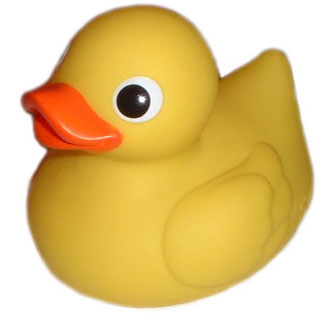What sort of significance can be found in a rubber duck? Clearly, a question that has been asked by scholars the world over for the past several centuries. Rubber ducks aren’t really important enough to talk about, is what most sensible people would say. I, however, am idiotic and determined.

This idea came to me as a result of my recent obsession (for lack of a better word) with Rubber Ducking (rubber duck debugging, teddy bear debugging, rubber duck problem solving, etc). It’s a process where somebody takes something that is not human, personifies it, and explains their problem, in detail, to that thing. It could be a rubber duck, a teddy bear, a cardboard cutout of a celebrity, it could be anything. I, personally, have a plastic skull named Ichabod. Because, however, I first learned about this with rubber ducks, that’s what the focus is on.
The idea is to make a rubber duck model that people can 3-D print for the purpose of this problem-solving method. It will be designed with a couple of things in mind. Firstly, it needs to be easy to personify. There are some design techniques I can employ to make a plastic monochrome duck easy to personify. Secondly, I am going to design it with size in mind. If it’s too small, a person may as well be talking to the air, and if it’s too large, than there’s no effective way to store it while not in use, and it may become more of a hindrance than a help. I’m thinking around the size of a baseball. Lastly, I will design it with the knowledge that I am designing a plastic rubber duck, and that nobody will take it as seriously as I am. If somebody has access to a 3-D printer, and they need to use this method of problem solving, they can print a duck to which they can explain their problems, once my design is finished.
This is important for a couple of reasons. It’s more about what the duck symbolizes and its function than the duck itself. Sure, it’s a rubber (plastic, I know, but I will continue to say rubber because it sounds better) duck, but it is the ultimate tool for problem solving. It’s because, when we think, we use different parts of our brains than we do when we try to explain or when we try to ask questions. Therefore, explaining to a rubber duck, or asking a question to a rubber duck causes us to think through the problem more logically, and in wider more understandable terms. On top of that, one of the questions we’re working with right now has to do with our relationship to objects, and in a way, this is a different kind of relationship to objects. People don’t try to explain things to their phones, and blind people don’t try to explain things to their sticks.
Now, this is a pretty recent thought. The idea of understanding something better through trying to explain it isn’t new, in 1980, an education method known as “learning by teaching” was developed by a foreign language teacher in Germany by the name of Jean-pol Martin. It’s largely the same idea, that explaining something allows a person to develop deeper understanding of the concept. Using inanimate objects to problem solve, however, is still fairly new, and largely dominated by the field of coding and programming. The first instance I could find of it was in a book called The Pragmatic Programmer by Andrew Hunt and David Thomas, which contained a story about a programmer who would carry around a rubber duck and force himself to explain his code, line-by-line, to it. However, there are stories of the same logical tool being used in other fields. I found a story online, in which a man working with automatic fire sprinklers, stopped by his boss’s office to ask a technical question, and was referred to a dead duck hanging on the wall. Halfway through asking his question, he found the answer. There are also stories of people using teddy bears, and pictures of political figures.
The real question that stands to be asked, is what will be gained from exploring this concept over the next several weeks? I believe that by exploring this concept and looking deeper into the psychological reasoning behind it, I will be able to find some incredible fact about the way the human mind relates to objects. How can something like a rubber duck become so important that somebody carries it around with them while they’re working?
Bibliography
“Creating Passionate Users: Rubberducking and Creativity.” 2014. Accessed October 21. http://headrush.typepad.com/creating_passionate_users/2005/01/rubberducking_a.html.
Hunt, Andrew. 2000. The Pragmatic Programmer: From Journeyman to Master. Reading, Mass: Addison-Wesley.
“Hwrnmnbsol – Ask the Duck.” 2014. Accessed October 21. http://hwrnmnbsol.livejournal.com/148664.html.
Kernighan, Brian W. 1999. The Practice of Programming. Addison-Wesley Professional Computing Series. Reading, MA: Addison-Wesley.
“ Re: Not an Awk Question.” 2014. Accessed October 21. http://lists.ethernal.org/oldarchives/cantlug-0211/msg00174.html.
“Rubber Duck Debugging.” 2014. Accessed October 21. http://www.rubberduckdebugging.com/.
“Rubber Ducking.” 2014. Accessed October 21. http://c2.com/cgi/wiki?RubberDucking.
“Rubber Duck Problem Solving.” 2014. Accessed October 21. http://blog.codinghorror.com/rubber-duck-problem-solving/.
“The Concept „Learning by Teaching“ – Ldl-Engl.pdf.” 2014. Accessed October 21. http://www.joachim-grzega.de/ldl-engl.pdf.
